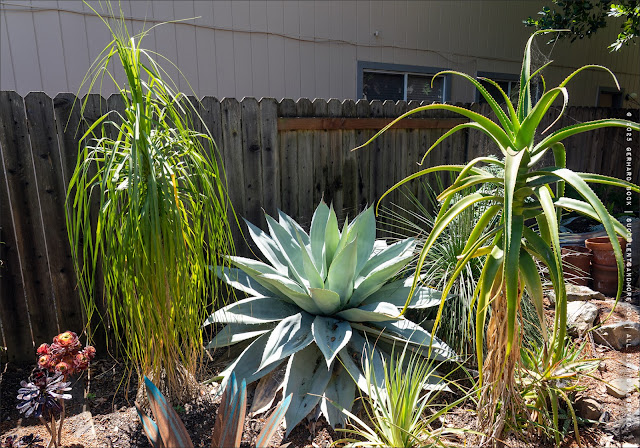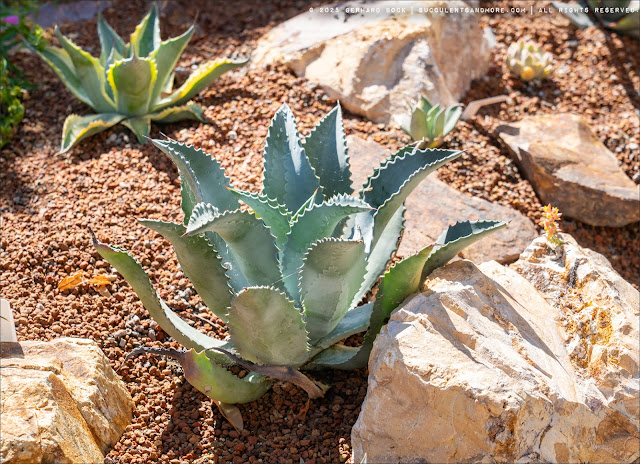Last fall I began to redo the side yard on the north side of our house. For far too long, it had been an unloved and neglected part of the backyard. But since real estate available for gardening is at a premium on our 8,100 sq. ft. lot, I finally got off my butt and began to dig in.
This post from early October shows you what the area looked like before, during, and immediately after I built the two new mounds. I’ve been making tweaks to both beds almost constantly, and it’s high time for an update.
Let’s start with the smaller mound. It, too, has evolved, but the changes aren’t as noticeable as they are in the larger mound, which we’ll get to in a minute.
 |
| October 8, 2024 |
In practically all of these photos, you’ll notice that both mounds, and the path between them, now have a layer of 5/16" red lava as a top dressing. Beyond that, there are more plants than back in October — not exactly a surprise considering a) how much I love plants, and b) how many plants I have waiting to go in the ground.
 |
| June 19, 2025 |
 |
| June 19, 2025 |
 |
| Lepidozamia peroffskyana is a palm-like cycad native to Eastern Australia. It has been doing beautifully in this large ceramic pot. It’s not a succulent, but it goes well with the succulents around it. |
A few close-ups of notable plants:
 |
| Hechtia argentea |
 |
| Agave petrophila |
 |
| Agave cremnophila |
 |
| Aloe ankoberensis from Ethiopia, still small but growing fairly quickly |
 |
| Looking from the east fence towards the house. The mess along the side of the house will be cleaned up later in the summer when we’ll have new siding installed. |
The plants in the next three photos are up against the east fence. They’ve been here for a number of years, but I want to include them in this post because they form the backdrop for the smaller succulent mound.
 |
| Beaucarnea recurvata, Agave ovatifolia ‘Vanzie’, Aloe helenae |
 |
| Aloe helenae, Agave geminiflora, and Agave ovatifolia ‘Vanzie’ in the back |
 |
| Agave ovatifolia ‘Vanzie’. I bought it in May 2014 in a 15-gallon can; it was already 2 ft. wide then (see post here). Considering it’s 13-15 years old now, it imagine it will flower soon – and then die. |
 |
| I wasn’t looking for another Agave ovatifolia ‘Vanzie’, but when I found this one in a batch of 5-gallon plants at a big box garden center, I had to grab it ($22.95!). The variegation isn’t pronounced, but it’s definitely there. It will eventually replace the ‘Vanzie’ above. |
Moving on to the larger mound on the north side of the house, starting with a few potted plants:
 |
| Macrozamia macdonnellii, a tough cycad from Australia’s Northern Territory where it grows in hot and dry places in the MacDonnell Ranges. It’s perfectly suited for our climate, but it’s hard to find and larger specimens are very expensive. I’ve had this one for a number of years, and it’s still small. |
 |
| Gasteria excelsa, one of the largest gasteria species, is perfectly happy in full sun. Behind it (top right) is a Joshua tree (Yucca brevifolia), which grows at a rate of about 1" a year. |
 |
| Other potted plants include an Encephalartos ferox and Encephalartos msingianus × arenarius, both of which I got for under $20 years ago |
What this mound looked like in early October 2024:
 |
| October 8, 2024 |
What it looks like now:
 |
| June 19, 2025 |
More details:
 |
| Clothesline and greenhouse beyond |
 |
| The black racks against the fence are for plants that spend the winter in the greenhouse. In the summer, they live outside because it’s too hot in the greenhouse. |
 |
| After I saw a bellflower (Campanula) in my friend Kyle’s garden, I decided to add a couple to the larger mound. They’ve been flowering profusely for weeks now. I couldn’t be more pleased with the result. |
 |
| Campanula ‘Cariboo Forte Blue’ — weird name, I know... |
 |
| ...but a cool plant |
The perennials in the larger mound (Salvia ‘Amethyst Lips’, Lavandula × intermedia ‘Phenomenal’, Penstemon heterophyllus ‘GMR White’, Penstemon ‘Red Rocks’, Agastache ‘Ambrosia’) have been stellar performers, adding much needed pops of color. They’re slowing down a bit now that we’re moving into summer, but I’m hoping for another wave of flowers in the fall.
A few plant close-ups:
 |
| Agave pablocarrilloi × isthmensis |
 |
| Manfreda undulata ‘Cherry Chocolate Chip’ surrounded by Artemisia pedemontana, a low-growing wormwood from Italy that I’ve planted in multiple spots, both in the front and the backyard |
 |
| Mangave ‘Frosted Jade’, a sport of ‘Frosted Elegance’ |
 |
| Agave parryi var. truncata ‘Orizaba’. This used to be rare as hen’s teeth (and correspondingly expensive), but thanks to the miracle of tissue culture, it’s now becoming more widely available and is much, much cheaper. |
 |
| Echeveria inflorescence |
 |
| Dudleya brittonii, with Dudleya cymosa on the right |
 |
| Myriopteris (formerly Cheilanthes) covillei, a dryland fern native to the southwestern United States and Baja California |
 |
| These potted cacti are part of my haul from my San Diego trip in April. They’re hanging out here for a little while until they’re big enough to be planted in the ground. |
Of course the work I do doesn’t go unsupervised:
 |
Stella making sure that everything is done properly
|
 |
| Always on duty |
I like to add a bit of
bone meal when I plant new plants, both in pots and in the ground, because it promotes healthy root growth. As it turns out, bone meal is to Stella what catnip is to cats. She has dug up several newly grounded plants and (
probably definitely) eaten some of the bone meal. Google says bone meal isn’t inherently toxic to dogs, but ingesting large amounts can cause intestinal obstructions. Knowing how much she likes it, I won’t use it in the backyard anymore, only in areas she has no access to. (The same caution applies to blood meal, which I also use as an organic source of nitrogen.)
 |
| Being a garden supervisor makes you tired! |
© Gerhard Bock, 2025. All rights reserved. To receive all new posts by email, please subscribe here.

















































Your Aloe Helenae is beautiful. I have a smaller specimen happily growing in my back yard, but I’ve heard stories about their acute sensitivity to frost (30’ F) and/or excessive sun. Have you experienced anything similar ? How long have you had it outside/in the ground ?
ReplyDeleteThe new bed is coming along beautifully !!
I have two helenae, one in the backyard (the one in this post) and one along the driveway. The first one is in full sun and the second in 1/2 day sun. Neither one has suffered frost or sun damage. I think this is another case of an aloe being noticeably hardier than initially thought.
DeleteLove the new area and your choice of plants of course. Happy to see the white and yellow pentstemon, that cycad from Australia and your campanula especially though all the textures and colors are great. I wonder if you’ve seen this campanula growing near the pond at the RBG? Thought it looked good there. https://flic.kr/p/2rcYfgu
ReplyDeleteThank you, Mark. Much appreciated coming from a gardener of your calibre.
DeleteThe bellflower at the RBG is Campanula incurva. See https://ruthbancroftgarden.tumblr.com/post/752768094731108352/campanula-incurva-plants-in-campanula-are-often.
The beds are coming along nicely. Nothing like a nice top dressing to finish everything off. Interesting you grow Gasteria in full sun. Here it burns. Must be the difference in elevation and perhaps humidity levels. Gardening with pets can be fun. I have to watch what I plant as our pets love to taste everything.
ReplyDeleteMost gasterias (esp. the small ones) don't tolerate full sun, but at least two of the larger species (excelsa and acinacifolia) do.
DeleteOh sweet Stella! I love the addition of the bellflower (and the pops of other blooms). I'm completely enamored with your agave & mangave (Frosted Jade!) they look perfect. 15 years, now that is a slow grower. I really like the trio of potted cacti, just the way they are - the sun is hitting them so nicely in that photo. And, of course your rocks are wonderful. This area is really superb, you must be delighted. Agave 'Tidal Wave' is going to be a stunner here!
ReplyDeleteThank you so much! I'll definitely post updates on everything. That bellflower, wow, it has far exceeded my expectations.
DeleteOops, that was me - Tracy
DeleteYou have SO many wonderful specimens. I fell in love with one agave after another (as well as some new-to-me Mnagaves) as a scrolled through your post. I was also enamored with your dwarf Artemisia. I'll try it if I find it, even though its zone 9a limit doesn't bode well for my 11a climate.
ReplyDeleteI've had many of the agaves (esp. the more uncommon ones) in pots for a number of years. They (and I) are happy they're finally in the ground.
DeleteI bet Artemisia pedemontana would do well in your climate.
I've been lucky enough to see these new garden beds develop over the last few months. It's looking fantastic! Great thing about it is now the hard work is done and you can watch it grow with small edits here and there. Congrats on the feat.
ReplyDeleteYou've been a big inspiration. There'd be far fewer rocks otherwise, haha.
DeleteThe editing is ongoing. Other than the initial planting, making tweaks is what I enjoy the most.
You said that your Joshua tree (Yucca brevifolia) grows 1" (one inch) per year. Is that correct? I would have thought/hoped that it would grow faster under cultivation, since it would get more water than in its native habitat.
ReplyDeleteI just measured it. It's 10" tall and 18" wide. I've had it for a good 10 years, and it was probably 3" tall when I got it. So growth rate is under 1". Maybe it'll pick up speed as it grows.
DeleteMine is no speed demon but after a year of setting up roots it’s now putting on ~3” per year. I believe they do pick up speed, especially if they don’t deal with the rigors of extended drought in the Mojave and can retain their lower leaves. There are impressively large specimens here in Salt Lake City so they clearly don’t mind seeing several feet of snow each winter.
DeleteI'm the "Anonymous" that originally asked the questions. Thank you both (Gerhard and the other Anonymous) for your answers.
DeleteFascinating post and glorious series of captures! Stella is delightful and beautiful. Thank you so much for sharing, and warm greetings from Montreal, Canada.
ReplyDeleteSo many plants, so many FABULOUS plants. Nice work Gerhard!
ReplyDelete